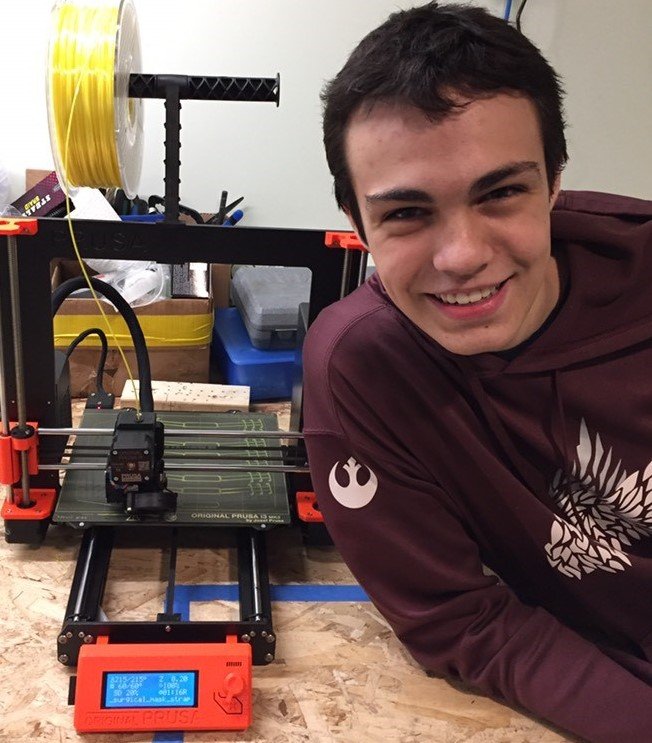Teen 3D printing project helps healthcare workers
Robotics club members ease ear discomfort from wearing masks
May 21, 2020
By Lisa Brunelle, Communications Advisor, Covenant Health
Getting used to wearing a mask for a full shift has been an adjustment for many staff who work in healthcare facilities.

“It definitely is a learning curve,” says Rebecca Watson, registered nurse in the emergency department at the Grey Nuns Community Hospital. “The elastics hurt the back of your ears, and it’s taken some time to get used to breathing through the masks.”
Alberta’s chief medical officer requires that all staff in healthcare facilities who can’t maintain social distancing at work wear a mask throughout their shift to keep others safe. A mask's elastic loops that hook onto the ears can chafe, causing discomfort. Before COVID-19, few staff would wear a mask for their whole shift.
But a group of teens has found a way to help ease the pressure of wearing masks all day.
The members of Cyber Eagle Robotics, which is part of the Strathcona County Robotics Association, were looking for a way to move past their disappointment of having qualified to compete at the FIRST World Championship in Houston, Texas, only to see the event cancelled due to COVID-19. They’re a team of 10 boys and girls in Grades 9-12. They came up with the idea of creating ear savers — a small piece of formed plastic that extends masks and elastics around the back of the head rather than the ears — after learning how uncomfortable wearing masks could be.
Due to family connections, the first site they approached with the ear savers was the Grey Nuns hospital.
“I love them!” says Rebecca. “With them, you still notice you’re wearing the mask, but it doesn’t hurt your ears.”
The plastic creations mean a lot to healthcare staff.
“It’s the little things that help people get through their day,” says Lana Chivers, senior director at the Grey Nuns hospital. “We’re in a stressful time with lots of new information. Sometimes it’s a simple gesture with the intent to make sure staff and physicians are comfortable and safe that goes a long way.”

One Cyber Eagle team member is making ear savers with a 3D printer, while others are reaching out to the community to find additional support for the project and ear saver delivery. They have invited other robotics teams to join them in the project, and two local teams ― Helios 5009 and Cyberflex ― have gotten involved.
Sanny Chan, a Dow Canada mentor for the team, says her chemical industry work means she understands the need for proper personal protective equipment. If it’s difficult to use, staff won’t wear it or they’ll wear it improperly. “Our goal is to get these ear savers out to the community care providers to be a small part of helping keep them safe and healthy.”
The Cyber Eagles found and downloaded a pattern for ear savers. Team member Jacob Zarowny, who had been involved in the 3D design of their FIRST Robotics competition robot, reviewed the design and made a few tweaks to make it feasible for their printers to print a lot of the savers.
When Sanny shared what the Cyber Eagles were doing with Dow, it offered a $4,000 grant to supply all the materials to make the ear savers. As well, as word spread about the project, more than 10 employees joined the project by using their personal 3D printers.
“At Dow, we're really lucky to have engaged employees who are willing to help with our community,” says Jessica MacDonald, site public affairs manager, Dow Canada. “Not only were we able to provide funding, but we also encouraged employees to give their time to help.”
The ear savers are made of PLA and PETG plastics, which are very similar to soft drink bottle plastic. They are easy for healthcare workers to clean and maintain proper infection control practices.
“They’ve hit the mark by being lightweight and easy to clean,” says Rebecca. “Everybody quite likes them.”
Lana says it’s important for staff to wipe the ear savers down appropriately after use. Staff cannot wear the ear savers in isolation rooms and can never use them with an N95 mask, due to the fact that they have been fit tested to these masks without the savers.
Currently, the Cyber Eagles are making 3,000 ear savers per week. And as of May 8, they had made more than 10,000 ear savers. They have given the ear savers to the Grey Nuns hospital, Mazankowski Alberta Heart Institute, University of Alberta Hospital, Fort Saskatchewan Community Hospital and Redwater Health Centre. They have also recently started offering them to community care providers like the Robin Hood Society in Sherwood Park and seniors’ homes across the region.
“I’m glad to be able to help out and want to thank the healthcare workers for taking care of people. I couldn’t do it because I’m not good at biology, so I couldn’t be a doctor,” says Jacob.
“I think the Cyber Eagles doing this shows a great sense of community where people are willing to jump in and help however they can,” says Rebecca. “It’s a great gift they’ve been able to give us.”